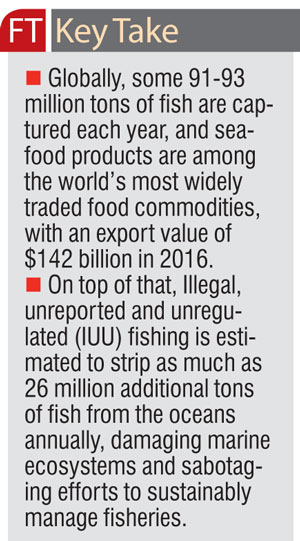Sunday Dec 15, 2024
Sunday Dec 15, 2024
Tuesday, 23 May 2017 00:00 - - {{hitsCtrl.values.hits}}
An FAO-led push to establish internationally agreed standards that can guide the development of catch documentation schemes aimed at keeping illegally caught fish off store-shelves and consumers’ plates has taken an important step forward.
A set of draft Voluntary Guidelines on Catch Documentation Schemes was recently unanimously adopted by a technical consultation that brought a five-year negotiation effort to a close, and are now poised for adoption by all FAO Members at the UN agency’s upcoming bi-annual governing conference (Rome 3-8 July 2017).
Once approved by the Conference, the guidelines will act as an internationally-recognised ‘gold standard’ reference for governments and businesses looking to establish systems that can trace fish from their point of capture through the entire supply chain – from ‘sea to plate’ – in order to stop illegally caught fish from entering the marketplace.
Globally, some 91-93 million tons of fish are captured each year, and seafood products are among the world’s most widely traded food commodities, with an export value of $142 billion in 2016.
On top of that, Illegal, unreported and unregulated (IUU) fishing is estimated to strip as much as 26 million additional tons of fish from the oceans annually, damaging marine ecosystems and sabotaging efforts to sustainably manage fisheries.
Catch documentation schemes (CDS) offer a way to cut down on trade in illegal fish. The basic concept: shipments of fish are certified by national authorities as being caught legally and in compliance with best practices; certifying hard-copy documentation then accompanies the fish as they are processed and marketed nationally or internationally. Only fish with valid documentation can be exported or traded to markets where a CDS requirement exists.
Until recently, only a few such schemes had been established, and mostly focusing on high-value species whose overexploitation prompted particular concern, such as Chilean Seabass harvested in Antarctic waters, or Atlantic and Southern Bluefin Tuna.
But with seafood trade at record highs and consumer demand still rising, catch documentation schemes are increasingly seen as a tool that could be more widely applied. Indeed, the EU since 2010 has used a CDS that covers all fish shipments imported into the bloc from overseas; and in 2016, the United States announced its own scheme, the Seafood Import Monitoring Program.
International buy-in critical
One challenge facing broader use of CDS relates to the logistics of ensuring that a paper certificate safely makes it from a fishing port in one country to an inspection station in another. The new guidelines recommend moving beyond paper-only documentation, so that information on fish shipments is recorded preferably in a digital system that can be referenced at any point along the value chain, reducing administrative burdens but also cutting down on fraud opportunities.
To function well, CDS need to be relatively simple and adaptable to different fisheries circumstances, so that diverse actors across the supply chain will find them both useful and ‘user friendly’ – something the new guidelines call for.
“CDS will only succeed if there is strong, international coordination,” explains Audun Lem, Deputy-Director of FAO’s Fisheries and Aquaculture Policy and Resources Division and current Secretary of FAO’s Sub-Committee on Fish Trade.
“Although they are voluntary, the process of negotiation that led to the new guidelines means they enjoy a high level of buy-in by governments, while endorsement at the FAO Conference will send a clear signal of commitment to adhere to them. So, going forward, new catch documentation schemes established at the national, regional or international level will be in sync, reducing barriers to their wider use,” he said.
Additionally, because the guidelines call on countries to comply with existing international laws as well as agreements established under the World Trade Organization, relying on them to develop CDS will allow countries to avoid unwanted trade disputes, Lem added.
New tools for tackling a pernicious problem
Fishing without permission, exceeding catch quotas, catching protected species, using outlawed types of gear are among the most common IUU fishing offenses.
Such practices not only undermine the global seafood industry as a whole, but can be particularly devastating for the millions of people around the world who depend on fishing for their livelihoods and as a critical source of protein and vitamins.
Growing international awareness of the problems tied to IUU fishing has helped build momentum behind international efforts to respond, such as the new CDS guidelines.
Another example is the FAO Port State Measures Agreement (PSMA) that entered into force last year, making history as the first international treaty specifically designed to prevent fishing vessels engaged in IUU fishing activities from entering ports, using port facilities, and landing their catches. The PSMA’s first meeting of parties - which now number 44, including the European Union – will take place next month in Oslo.
“IUU fishing is bad for the environment, is bad for food security, and is bad for economic development, which is why it is targeted for action under the 2030 Sustainable Development Agenda. The voluntary guidelines on catch documentation schemes puts yet another tool in the anti-IUU toolbox, alongside the PSMA, the FAO International Plan of Action on IUU fishing, and our Voluntary Guidelines for Flag State Performance,” said Lem.